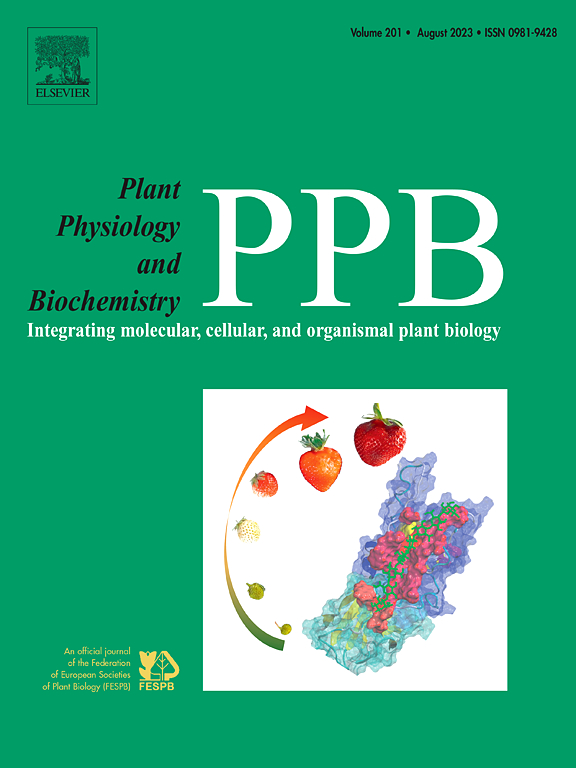高温下未受精豌豆花的转录组定位:基因调控网络基因组学资源的见解
IF 5.7
2区 生物学
Q1 PLANT SCIENCES
引用次数: 0
摘要
热胁迫是影响豌豆生产的最重要的环境制约因素,其耐热机制是通过多种途径介导的。豌豆(Pisum sativum L.)品种Arka Chaitra (AC)被认为是耐热品种,而栽培品种Matar Ageta (MA)是热敏品种。在对照和热胁迫(HS)条件下,对2个豌豆品种AC和MA进行了转录组分析,以阐明其耐热性的分子机制并鉴定相关基因。在本研究中,我们首次报道了AC和MA在HS条件下的形态生理性状,即荚果数(PNP)、荚果重(PW)、种子数/荚果(SNP)和种子/荚果重(SW)。随后进行花粉活力测定,进一步研究HS下花粉的行为。形态生理分析表明,与MA相比,HS处理下AC的荚果和种子数量更多,荚果和种子质量更高。此外,品种AC的花粉活力降低了23%,而品种MA的花粉活力降低了41%,表明AC在HS条件下表现出强大的耐受机制。在此基础上,研究人员利用RNA测序技术(RNA- seq)对AC和MA品种的转录组进行了分析,进一步探讨了其调控机制。我们选择了包括热休克转录因子和热休克蛋白在内的一个基因子集,使用定量RT-PCR验证RNA-Seq表达模式,结果显示AC中的表达水平高于MA。此外,基因本体(GO)分析发现,与花粉和花朵发育、热应激蛋白和质体发育相关的GO术语在耐受性品种中显著富集,而与细胞形态发生、细胞生长和细胞壁生物发生相关的GO术语在易感品种中富集。这些发现为豌豆品种AC和MA耐热性的基因和途径提供了深入的分析。本文章由计算机程序翻译,如有差异,请以英文原文为准。
Transcriptome mapping of unfertilized pea flowers under high temperature: insights into gene regulatory networks genomics resources
Heat stress is the most significant environmental constraint on pea production, and heat tolerance mechanisms are mediated through a variety of pathways. Pea (Pisum sativum L.) cultivar Arka Chaitra (AC) is considered a heat tolerant variety, whereas cultivar Matar Ageta (MA) is heat sensitive. Transcriptome profiling of two pea cultivars, AC and MA, was conducted under control and heat stress (HS) conditions to elucidate the molecular mechanisms and identify genes associated with heat tolerance. In this study, we initially reported the repertoire of morpho-physiological traits namely pod number (PNP), weight of pods (PW), seed number/pod (SNP) and weight of seed/pod (SW) during HS conditions in AC and MA. Subsequently, Pollen viability assay was performed to further examine the pollen behavior under HS. Morpho-physiological analysis revealed that cultivar AC exhibited greater number of pods and seeds, as well as higher pod and seed weights, compared to MA under HS. Furthermore, pollen viability in cultivar AC was reduced by 23 %, whereas in cultivar MA, it was reduced by 41 %, indicating that AC exhibits robust tolerance mechanisms under HS conditions. Based on these observations, we delve deeper to investigate the regulatory mechanisms by profiling the transcriptomes of cultivars AC and MA using RNA Sequencing (RNA-Seq) under HS. We selected a subset of genes, including heat shock transcription factors, and heat shock proteins involved in heat resilience, to validate the RNA-Seq expression patterns using quantitative RT-PCR, which revealed higher expression levels in AC compared to MA. Furthermore, gene ontology (GO) analysis of the identified DEGs revealed significant enrichment of GO terms associated with pollen and flower development, heat stress proteins, and plastid development in the tolerant variety, whereas, the susceptible variety was enriched with GO terms related to cell morphogenesis, cell growth, and cell wall biogenesis. These findings provide in-depth analysis of genes and pathways contributing to thermotolerance in pea cultivars AC and MA.
求助全文
通过发布文献求助,成功后即可免费获取论文全文。
去求助
来源期刊
CiteScore
11.10
自引率
3.10%
发文量
410
审稿时长
33 days
期刊介绍:
Plant Physiology and Biochemistry publishes original theoretical, experimental and technical contributions in the various fields of plant physiology (biochemistry, physiology, structure, genetics, plant-microbe interactions, etc.) at diverse levels of integration (molecular, subcellular, cellular, organ, whole plant, environmental). Opinions expressed in the journal are the sole responsibility of the authors and publication does not imply the editors'' agreement.
Manuscripts describing molecular-genetic and/or gene expression data that are not integrated with biochemical analysis and/or actual measurements of plant physiological processes are not suitable for PPB. Also "Omics" studies (transcriptomics, proteomics, metabolomics, etc.) reporting descriptive analysis without an element of functional validation assays, will not be considered. Similarly, applied agronomic or phytochemical studies that generate no new, fundamental insights in plant physiological and/or biochemical processes are not suitable for publication in PPB.
Plant Physiology and Biochemistry publishes several types of articles: Reviews, Papers and Short Papers. Articles for Reviews are either invited by the editor or proposed by the authors for the editor''s prior agreement. Reviews should not exceed 40 typewritten pages and Short Papers no more than approximately 8 typewritten pages. The fundamental character of Plant Physiology and Biochemistry remains that of a journal for original results.

 求助内容:
求助内容: 应助结果提醒方式:
应助结果提醒方式:


